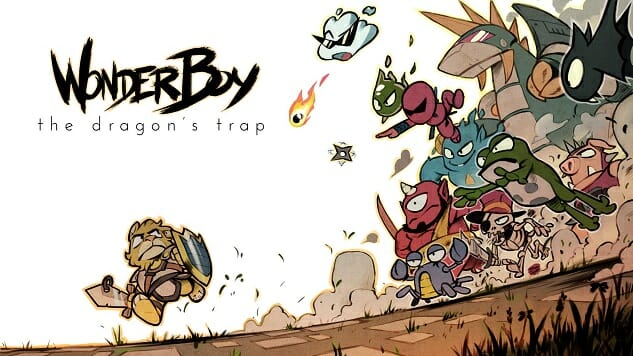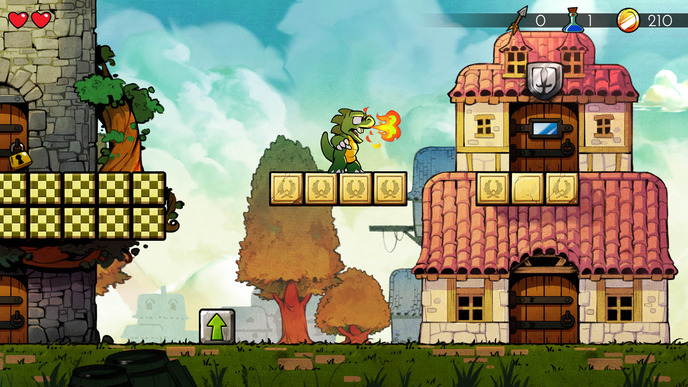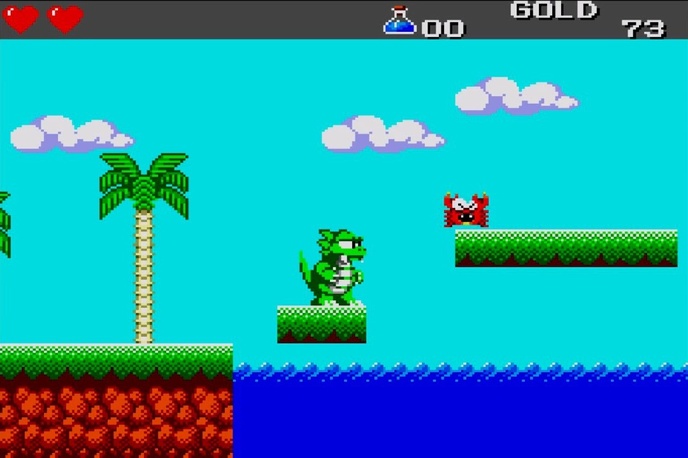
As time progresses, archiving and preserving classic videogames has become a Herculean task. Staggered international releases, localization issues and copyright disputes are some of the many obstacles developers face when attempting to revive or restore games of a bygone era.
This is especially true of the Wonder Boy franchise. A Sega property, Wonder Boy has evolved dramatically in its over thirty year lifespan. It began as an action platformer with a caveman-like character on a tropical island, and then morphed into a lite RPG with upgradable weapons and, in later sequels, spell slots. Released primarily on the Sega Master System and the Sega Mega Drive, the Wonder Boy franchise contains multiple sequels and a sub-series called Monster Land. Its lineage is a wall strung with yarn and thumbtacks, branching continents, languages, and legal negotiations spanning multiple decades.
Reviving a Dream
The idea to bring back the Wonder Boy series isn’t a sudden one. As a longtime fan of the franchise, Lizardcube Games co-founder Omar Cornut has long dreamed about reviving it for modern platforms.
“It was literally something I fantasized about twenty years ago,” he says, explaining how his longtime love for Sega consoles, the Master System in particular, has driven him toward keeping them relevant for future generations.
“I’ve [always] been a big fan of the old Sega systems, and I want to preserve the old games,” Cornut says. He settled on a remake of a Wonder Boy game. When developing ideas for the project, he and Lizardcube co-founder Ben Fiquet turned their attention specifically to Wonder Boy III: The Dragon’s Trap. A confusing anomaly in the Wonder Boy series, The Dragon’s Trap is actually recognized as the fourth in the series in Japan, but is labeled as such because it is the third Wonder Boy game available on the Sega Master system internationally. According to Cornut, fan demand was a large factor in deciding to choose The Dragon’s Trap as Wonder Boy’s modern revival.
“This game has a following, so we knew it would gain traction,” he says.
Cornut is familiar with the passion inherent in classic game fandom and wanted to do right by the fans, the series, and the game itself. To do so, he trained himself in breaking down The Dragon’s Trap to an atomic level, painstakingly charting every encounter, item, enemy, and secret in the game itself.
Still, he was left with unanswered questions, unsure of technical aspects including how the hit boxes within the game were animated or which rules item drops adhered to. In order to get the answers he needed to create a new game in the most faithful way possible, he turned to a rather drastic method for obtaining answers: he dumped the code off of the cartridge and began studying the game’s internal pieces by reverse engineering.
“We wanted to make a game that was very faithful to the original. So, we put a lot of effort and tech into reverse engineering the code to get something that felt like the original, so we didn’t mess that up,” he says. “What we have now is really close to the original.”
Through this method, he was able to better understand practically every element of the game, bypassing the confusing proprietary methods used in the early days of game development through studying its individual components. With Fiquet, Cornut began crafting the most faithful revival he could possibly create, despite knowing his biggest challenge was yet to come.
Fight for Your Rights
Reviving classic games for modern players is a noble cause that often carries massive legal implications. The older the game, the messier the state of copyright and trademark ownership. Rights are acquired, companies are sold, and seemingly innocuous aspects of a franchise are auctioned off and sent to die deep within the files of a long-defunct company.
Wonder Boy was initially developed by Westone and published by Sega, but the two had a licensing agreement that gave Sega ownership of the Wonder Boy trademark while allowing Westone to maintain ownership of the intellectual property. Westone eventually declared bankruptcy, and the IP was passed on to LAT Corporation while Sega maintained the rights to the name.
If Lizardcube was to faithfully remake The Dragon’s Trap, Cornut and Fiquet knew they would have to obtain the rights and blessing of the IP and trademark holders. They first approached the original creator, Ryuishi Nishizawa, who approved of their project and shared information about its development with them.
Despite not yet having full permission to use the Wonder Boy name and likeness, Cornut and Fiquet continued to work on the project, keeping in mind ideas of how to distance themselves from the IP should rights usage negotiations fall apart.
“We were about halfway through [development], but we were unsure it would happen. We happened to persevere and just kept pressing on to get the thing done,” Cornut says. He jokingly says they would have made it Wonder Girl if necessary to avoid copyright infringement.
A Long Seven Months
After learning how the rights were divided between Sega and the LAT Corporation, Cornut and Fiquet approached DotEmu CEO Cyrille Imbert and presented him with the project. Being that DotEmu is a publisher focused on reviving classic franchises, Imbert considered Wonder Boy a good project to pursue. Especially, he says, because of how well it has aged.
“At DotEmu we are always looking for old licenses to dig up and remake,” he says of the company. “And finding a game that old that plays that [well] is super rare. So, it totally made sense.”
Imbert is not new to working with Japanese companies to obtain rights usage permission, having previously done so to help bring about the revival of Windjammers. Shortly after meeting with Lizardcube, he began working on negotiations with both Sega and LAT Corporation.
The process was long and challenging, often yielding conflicting and confusing results.
“At one point, it was not really clear who owned the copyrights,” Imbert recalls, laughing. According to him, new documents would be discovered that would muddy the once-clear delineation of who owned which parts of the IP and trademark.
Fortunately, having the project in a displayable state worked to their advantage in swaying Sega and LAT. Seeing the efforts of the developer to create a faithful, respectful revival of the IP provided incentive to give permission to Lizardcube and DotEmu.
Seven months and multiple Japan trips later, they were able to get proper clearance from both companies, entering an agreement with Sega that would allow them to use the original Wonder Boy name and likeness.
The process itself was a stressful one for all involved, and at times looked less and less likely to get the go-ahead. Still, Cornut and the others continued development and negotiations, fueled by the passion to bring Wonder Boy back for the modern age. According to Imbert, the entire process was not complicated, so much as time-consuming and trying.
“At some point, we knew it was worth it, but we were like ‘it’s never going to happen,’ because Japanese companies can sometimes take forever,” he explains, highlighting the challenges inherent in a cultural divide between businesses.
“You have to be patient, you have to convince them that the project is cool, that you’ll respect the license, that they won’t be in danger or anything, and that’s how it came out,” he says. “It was a pretty flawless process, it just took some time.”
Wonder Boy Awakens
Hoping to keep it from becoming too confusing for new players, Cornut and Fiquet decided to opt out of including a number in the title.
“We actually removed the number from the title to be more inclusive and not scare people who [would have] wanted to start from the beginning. The Dragon’s Trap [was] the best way to identify this game.”
Nearly every aspect of The Dragon’s Trap has been carefully engineered to pay homage to its predecessor, all the way down to the enemy designs and encounters. Like the original, The Dragon’s Trap is built upon a body-switching mechanic giving Wonder Boy access to new animal forms, each with their own unique set of strengths and abilities. Lion Man hefts a large sword with a great deal of power, Mouse Man can scale special walls and defy conventional physics within the game, and Hawk Man can fly and glide from platform to platform. There are five total monsters into which Wonder Boy can transform, each a curse placed upon him by a vanquished dragon boss.
Fiquet’s art is warm and bold, evoking the familiar, comforting spirit of both Bone and Calvin and Hobbes. Every frame of animation has been painstakingly created by hand, each environment is sprawling with vibrant color and depth, and enemies have their own quirky designs and movement patterns that prove both entertaining and telling of their individual personalities.
Taking the faithfulness a step further, the entire soundtrack from The Dragon’s Trap has been adapted by a multi-piece orchestra, resulting in brilliant compositions that nicely complement the game’s whimsical art style.
But perhaps the most faithful feature of all is the ability to swap aesthetics from Fiquet’s art to the original pixel art from the Master System version and swap music with the chip tunes of classic Dragon’s Trap. It’s customizable, allowing for newcomers to experience a game heavily influenced by history and giving longtime fans the chance to relive the classic from the perspective they once experienced as a child.
Changes are minimal and largely restricted to the technical side of things, including tweaks to the physics, frame rate, storytelling and available difficulty levels. In addition to classic graphical and musical options, Cornut has also built a password entry into the new game that will take legitimate codes from the 1989 original and transport players to decades-old save points.
Put simply, it’s Cornut’s vision come to fruition: a faithful and legitimate remake splashing the screen with a new coating heavily influenced by his adoration for the Wonder Boy games of old. While the process may have been challenging, he maintains throughout our conversation that it has always been worth it.
“This is a game that I have [always been] wanting to make,” he says, grinning. “And it just so happened that three years ago, the time was right, and we just went for it.”



